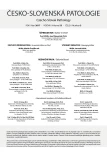Parallel investigations of blood and alveolar air in the diagnosis of lethal carbon monoxide poisoning
Authors:
Miroslav Bauer 1; Jiřina Bauerová 1; Peter Očko 2; Jozef Šidlo 3
Authors‘ workplace:
Ústav súdneho lekárstva, Lekárska fakulta, Slovenská zdravotnícka univerzita, Bratislava
1; Súdnolekárske pracovisko, Úrad pre dohľad nad zdravotnou starostlivosťou, Bratislava
2; Ústav súdneho lekárstva, Lekárska fakulta, Univerzita Komenského, Bratislava
3
Published in:
Soud Lék., 62, 2017, No. 3, p. 33-36
Category:
Original Article
Overview
Carbon monoxide poisonings are the most frequent among fatal gas and volatile substances intoxications. The authors present diagnostic options of fatal carbon monoxide poisoning by parallel blood investigations for the content of karbonylhaemoglobin and determining of the concentration of carbon monoxide in the alveolar air. The analysis of 160 cases of lethal poisonings with carbon monoxide over a period of 20 years was carried out. The cases were divided into subgroups according to the place of death to poisonings in flats, garages, bathrooms, in fires, road traffic accidents and mining accidents. Tabular cases were divided into poisonings with a dominant share of carbon monoxide; the lethal concentration (0.075 % volume percentage or more) in the alveolar air was found in 75 % of cases. By pairs of victims different concentrations of carbon monoxide in the alveolar air were found. It confirms the fact that the course of intoxication and time of death also depends on the state of health of an individual. In 25 % of cases composite action with other toxic substances and factors (cyanide ions, ethanol, carbon dioxide, smoke inhalation solids, burns etc.) was detected. The obtained results point to an important and irreplaceable role of the toxicological - chemical analysis of the alveolar air in the context of additional laboratory investigations at autopsy in the diagnosis of fatal carbon monoxide poisoning. Investigation of the alveolar air should be the standard methodological procedure in the diagnosis of fatal poisonings by gases and volatile substances.
Keywords:
carbon monoxide intoxication – evidence of carbon monoxide in the alveolar air – blood investigation for karbonylhaemoglobin – autopsy – toxicological analysis
Sources
1. Ševčík M. Akutní otrava kysličníkem uhelnatým. Praha: Avicenum; 1975.
2. Teige B, Lundevall J, Fischer E. Carboxyhemoglobin concentration in fire victims and in cases of fatal carbon monoxid poisoning. Rechtsmedizin 1977; 80: 17-21.
3. Wirth W, Hecht G, Gloxhuber Ch. Toxikologie Fibel. Stutgart: Georg Thieme Verlag; 1971, 469 s.
4. Porubský V. Fotometrické zisťovanie COHb v mŕtvolnej krvi. Soud Lek 1957; 2: 23-26.
5. Autorské osvědčení číslo 171795 Úřadu pro vynálezy a objevy v Praze, přihláška vynálezu PV 8113-72, Praha, 28. června 1978.
6. Autorské osvědčení číslo 172517 Úřadu pro vynálezy a objevy v Praze, přihláška vynálezu PV 1295-73, Praha 6. července 1978.
7. Bauer M, Bauerová J, Šikuta J, Šidlo J. Vyšetrovanie alveolárného vzduchu post mortem v súdnolékarskej praxi. Soud Lek 2016; 61(4): 44-49.
8. Šidlo J, Bauer M, Bauerová J, Valuch J. Diagnostics of fatal hydrogen sulfide poisonings. Soud Lek 2009; 54(3): 37-40.
9. Valent D, Šidlo J, Kuruc R, Očko P, Mlynár J. Analysis of fatal cases due to asphyxia and gas inhalation in a confined space. Fol Soc Med Leg Slov 2012; 2(2): 141-146.
Labels
Anatomical pathology Forensic medical examiner ToxicologyArticle was published in
Forensic Medicine

2017 Issue 3
Most read in this issue
- Oncology secrets of suddenly deceased individuals
- Parallel investigations of blood and alveolar air in the diagnosis of lethal carbon monoxide poisoning
